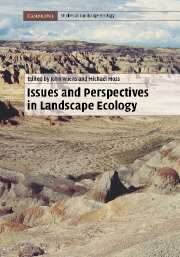Book contents
- Frontmatter
- Contents
- List of contributors
- Preface
- PART I Introductory perspectives
- PART II Theory, experiments, and models in landscape ecology
- PART III Landscape patterns
- PART IV Landscape dynamics on multiple scales
- 14 Landscape sensitivity and timescales of landscape change
- 15 The time dimension in landscape ecology: cultural soils and spatial pattern in early landscapes
- 16 The legacy of landscape history: the role of paleoecological analysis
- 17 Landscape ecology and global change
- PART V Applications of landscape ecology
- PART VI Cultural perspectives and landscape planning
- PART VII Retrospect and prospect
- Index
- Plate section
- References
15 - The time dimension in landscape ecology: cultural soils and spatial pattern in early landscapes
from PART IV - Landscape dynamics on multiple scales
Published online by Cambridge University Press: 20 November 2009
- Frontmatter
- Contents
- List of contributors
- Preface
- PART I Introductory perspectives
- PART II Theory, experiments, and models in landscape ecology
- PART III Landscape patterns
- PART IV Landscape dynamics on multiple scales
- 14 Landscape sensitivity and timescales of landscape change
- 15 The time dimension in landscape ecology: cultural soils and spatial pattern in early landscapes
- 16 The legacy of landscape history: the role of paleoecological analysis
- 17 Landscape ecology and global change
- PART V Applications of landscape ecology
- PART VI Cultural perspectives and landscape planning
- PART VII Retrospect and prospect
- Index
- Plate section
- References
Summary
Contributors to this volume have been invited to write personal statements and perspectives on their particular area of landscape ecology, and we accept this challenge even though we appreciate that our views may well be controversial. Our overall perspective is that landscape ecology is a science that primarily depends upon spatial analysis in order to elucidate landscape processes. The roots of the subject lie in landscape classification systems, an emphasis evident in many of the other essays in this volume. More flexible approaches are now evident, given that the notion of landscapes is largely a cultural concept. Such flexibility has been fostered by the application of GIS and image analysis techniques, and by incorporating economic methods of analysis. Nevertheless, landscape ecology is focused primarily on spatial rather than temporal differentiation as the analytical core. This is not to deny that temporal dimensions are explicitly included in the many definitions of landscape ecology, or that much research has been done on landscape change through sequential sampling, the analysis of aerial photographs, or other remote-sensed imagery.
The essential thrust of this essay is to argue that landscape ecology as a spatial science needs to find ways of interfacing with such subjects as environmental archaeology and history in order to combine spatial and temporal analysis. It is only with such a linkage to longer timescales that landscape ecologists can begin to understand long-term landscape processes and build robust models for predicting future landscapes.
- Type
- Chapter
- Information
- Issues and Perspectives in Landscape Ecology , pp. 152 - 158Publisher: Cambridge University PressPrint publication year: 2005
References
- 2
- Cited by



